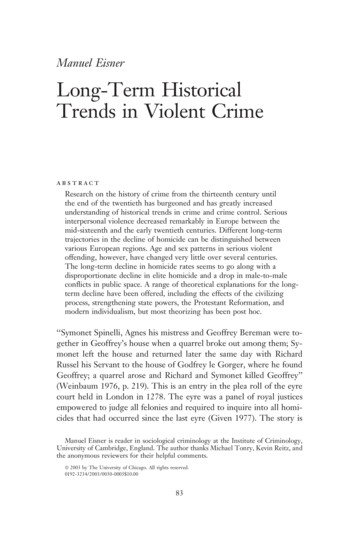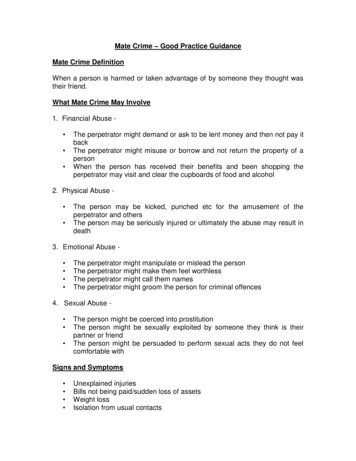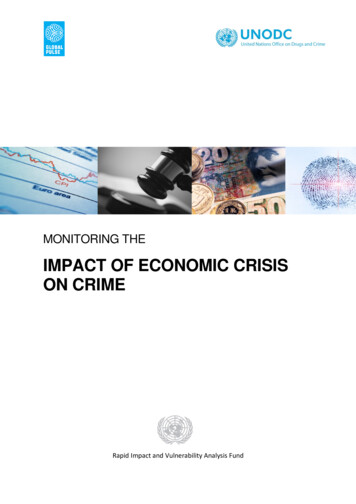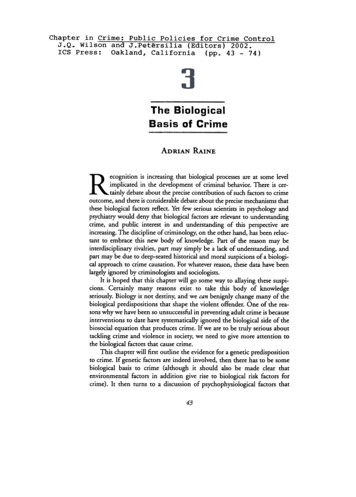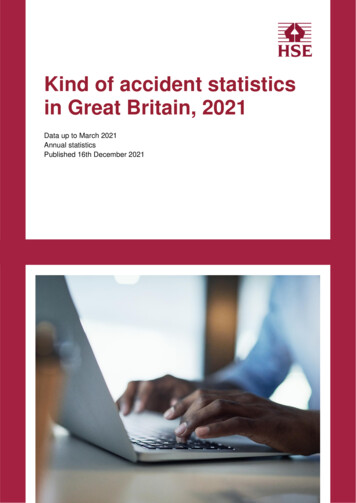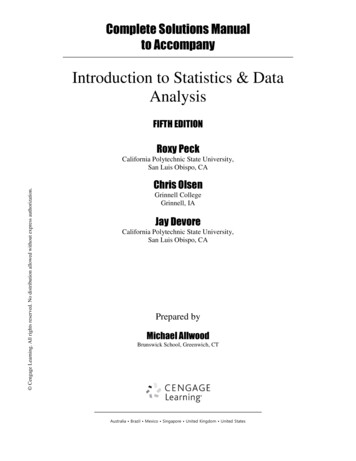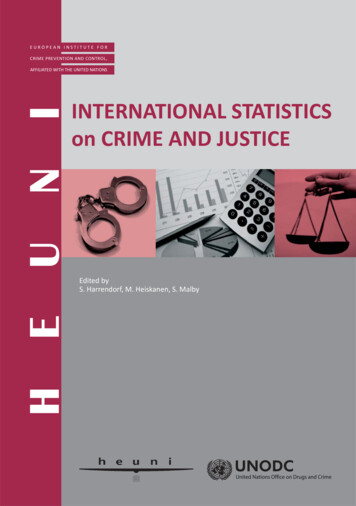
Transcription
EUROPEAN INSTITUTE FORCRIME PREVENTION AND CONTROL,INTERNATIONAL STATISTICSon CRIME AND JUSTICEUNIAFFILIATED WITH THE UNITED NATIONSHEEdited byS. Harrendorf, M. Heiskanen, S. Malby
European Institute for Crime Prevention and Control, Affiliated with the United Nations (HEUNI) P.O. Box 444 FINǦ00531 Helsinki Finland United Nations Office on Drugs and Crime (UNODC) PO Box 500 1400 Vienna Austria HEUNI Publication Series No. 64Stefan Harrendorf, Markku Heiskanen, Steven Malby (eds.) International Statistics on Crime and Justice Helsinki 2010 1
Disclaimers This report has not been formally edited. The contents of this publication do not necessarily reflect the views or policies of the United Nations, UNODC or contributory organizations and neither do they imply any endorsement. The designations employed and the presentation of material in this publication do not imply the expression of any opinion whatsoever on the part of the United Nations or UNODC concerning the legal status of any country, territory or city or its authorities, or concerning the delimitation of its frontiers or boundaries. ISBN 978Ǧ952Ǧ5333Ǧ78Ǧ7 ISSN 1237Ǧ47412
International Statistics on Crime and Criminal JusticeContents 1 2 3 4 5 6 7 8 Introduction . Kauko Aromaa Homicide . Steven Malby Trends in policeǦrecorded crime . Markku Heiskanen Drug crime . Steven Malby Complex crimes . Anna Alvazzi del Frate Responses of the criminal justice system . Paul Smit and Stefan Harrendorf Attributes of criminal justice systems – resources, performance and punitivity . Stefan Harrendorf and Paul Smit Trends in world prison population Roy Walmsley Crime and criminal justice statistics challenges . Anna Alvazzi del Frate 5 7 21 49 65 87 113 153 167 3
4
International Statistics on Crime and Criminal JusticeKauko Aromaa* The United Nations Surveys on Crime Trends and the Operations Criminal Justice Systems (denoted UNǦCTS below for the sake of brevity) collect basic information on recorded crime and on resources of criminal justice systems in the member states. Its mandate being Europe and North America, HEUNI has analysed and reported on the surveys for this part of the world from the very beginning. For other regions of the world, such reporting has not been achieved. The present volume, prepared in partnership of HEUNI and the UNODC, for the first time pulls together global responses to the UNǦCTS questionnaire, the most recent one included here is UNǦCTSǦ10 that allows the analysis of data up to 2006. In the current report, the improvement introduced in the previous one (looking only at Europe and North America; Aromaa and Heiskanen 2008) was retained: also this time, the report addresses a time period of about ten years in order to provide more stability to the situation assessment. In a global report, it is more difficult to keep to the tenǦyear framework since many countries have not responded regularly but data gaps are frequent. In this case, the basic solution has been that data for 1996, 2000, and 2006 are used for the tenǦyear (actually, elevenǦyear) perspective to be covered. For many countries, this could be achieved, for many others, one or more of these years had to be complemented by data for adjacent years because the country response for one (or several) of the required years had not been made available. Reporting for more recent years has not been possible. This may not be satisfactory to those who require more upǦtoǦdate information. However, the timeliness of largeǦscale comparative data has always been a significant problem and remains one. First of all, statistical data on crime and criminal justice are typically not available until after the relevant year. CountryǦlevel data on policeǦrecorded crime are often released relatively soon after the shift of the year, but statistics on later stages of the criminal justice procedure are more delayed. Next, disseminating the UNǦCTS data collection instrument to member states, collecting and validating the responses, drafting a reporting plan and creating a database necessary for the analysis, analysing the data and writing up the report are stages in the process that cannot be avoided, and they do consume time. IntroductionIntroduction As a consequence, reports of this kind are always providing results that do not refer to the current year or the previous one but will shed light on the situation 3Ǧ4 years back in time. So far, ways to introduce significant improvements to this dilemma have not been found. For many, a delay of 3Ǧ4 years would seem to be too long for an upǦtoǦdate assessment of the current situation, whether globally or for one region only, even considering that experience has shown that crime data of the kind analysed here usually do not vary radically over short time periods. A marked improvement would however require much more advanced statistical systems in many member s tates, and a much higher priority to be given to the UN data collection exercise than is the case today. Another, even more disturbing observation that has been made repeatedly is that many member states continue to be unable to answer the UNǦCTS questionnaire at all, or are only able to provide a partial response. This state of affairs is in part due to a very basic reason: some or all of the required data are not available. However, less excusable is the situation for many other countries that are known to possess the required data but do not respond. * Director, European Institute for Crime Prevention and Control, affiliated with the United Nations5
For those in need of improving their statistics, the UNODC has been working on a support and assistance approach which is also bearing fruit in the long term. Those member states that, for a multiplicity of reasons, have failed to respond to the Surveys although they are in the possession of the relevant data, should take this task more seriously in the future. This would also be in their own interest as they would benefit from knowing their position in a global dataset. Also others in the global community would be keen to know how others have been doing in core issues of crime and criminal justice. countries undergoing irregular rapid transformations – for such countries, however, a UNǦCTS is hardly of immediate interest anyway. Some of the unavoidable delay problems have been partially resolved by the UNODC in that they publish some data from the country responses on their website as soon as they are made available by the member states. The advantage is that the delay is as short as it can be under the circumstances, where national responses are the basis. Of course, before there is a national response, nothing can be made available. It is therefore of paramount importance that delays caused by member states are minimized. –The drawback of the UNODC solution is that the information on the website is not – and cannot be – validated and processed, leaving the potential user without expert assistance when trying to interpret the data. It is highly problematic and perhaps not advisable at all to publish raw data of this kind without adequate commentary regarding known problems related to its validity and interpretation problems. The report comprises eight chapters. They are designed to deal with all central issues addressed in the questionnaires. First, policeǦrecorded crime is discussed, with separate chapters on homicides (chapter 1), other policeǦrecorded crimes (chapter 2), and drugǦrelated crime and drug trafficking (chapter 3). Also, complex crimes are analysed separately, such as organised crime, and trafficking in human beings (c hapter 4). Such offences have played a marginal role in traditional crime statistics, and in order to improve the relevance of the data on such offences, new solutions need to be developed. Chapter 5, shifting to the next stage of the criminal justice system, presents data on responses of the criminal justice system, including an innovation where attrition issues are being discussed. A parallel issue to responses of the criminal justice system are resources and performance. These are discussed in chapter 6 where also a discussion on the punitivity of criminal justice systems is included. Next, a presentation on prison populations of the world closes the analysis of criminal justice data. The last chapter, finally discusses challenges with crime and criminal justice statistics, arguing for the importance of further improvements in the area. The tenǦyear time span applied should illustrate that for many criteria, it is often of no massive importance that the data are never fully up to date: many of the trends displayed can be seen to be rather stable, meaning that simple basic indicators of features of recorded crime and operations of the criminal justice system are often of a rather robust nature. Consequently, a large proportion of the presented data and findings, even if outdated, are unlikely to change significantly from one year to another. Consequently, the current delay in the timeliness of the presented data is mostly of no major concern. The most obvious exceptions are 6We have not reproduced the data collection instruments in this volume. Due to various changes over time, each UNǦCTS questionnaire is slightly different. The questionnaires can be found in all UN languages at the address: eǦSystems.html The objective of this report is to show potential users of international crime data what they could learn from these, and provide guidance as to restrictions, pitfalls and strengths of the unique set of data that is now available thanks to the countries that have responded to the UN Surveys.
International Statistics on Crime and Criminal JusticeSteven Malby* Abstract This chapter presents available data on the crime of intentional homicide – the intentional killing of a person by another. As one of the most effectively recorded crimes, law enforcement data on intentional homicide is typically more readily available than for other crimes. As such, rates of intentional homicide per 100,000 population have sometimes been used as a proxy for levels of violent crime or even overall crime. Data from both law enforcement and public health sources may be combined to increase data availability and geographic coverage. Results suggest that the highest homicide levels are found in the Americas and Africa region, with the lowest homicide levels generally in countries in Europe. For those countries where trend data is available, the majority show decreasing or stable homicide rates, with the exception of a number of countries, predominantly in the Americas that show high and increasing rates. Such increases may be linked to the challenges of organized crime, drug trafficking, and gang activity. Significant data challenges remain however, particularly in Africa, where criminal justice data on intentional homicide is presently very limited. HomicideChapter 1 – HomicideIntroduction The intentional killing of a person by another (‘intentional homicide’) represents the most serious end of the spectrum of violent crime. Recent attention on the issue of armed violence and the growing importance of homicide as an indicator has resulted in increased efforts to improve statistics at international, regional and national levels. The results presented in this chapter derive primarily from criminal justice data. Despite varying definitions, ‘homicide’ is perhaps the most widely collected and reported crime in law enforcement and criminal justice statistics. Due to its seriousness, the killing of a person tends to be recorded more effectively than other crimes. Nonetheless, the challenges of crossǦnational comparability are considerable. National legal systems may have different thresholds for categorising a death as intentional homicide. Whilst intentional homicide usually requires that the perpetrator purposefully intends to cause the death or serious injury of a victim, in some countries a death that occurs in the act or attempted act of another serious crime may also qualify as ‘intentional’ homicide or murder. Infanticide, assault leading to death and killings carried out by law enforcement officers (acting legitimately in the line of duty or not) all may or may not be included in policeǦrecorded statistics. In addition, differences in police recording practices such as differences in counting units (offences, suspects or cases), whether or not attempted homicide or nonǦintentional homicides are included in published figures, and the point in the investigation at which a suspicious death is classified as homicide all vary as between countries. Moreover, as forms of organized criminality and state insecurity become increasingly intertwined, the line between violent deaths that occur in armed conf lict and those that can be labelled ‘crime’ is often blurred. Acts which are likely to be recorded by law enforcement and criminal justice institutions as intentional homicide can take place in a wide range of contexts, including the home, family, social or domestic setting, in the course of burglary, theft or robbery, or associated with gang, organized, or drugǦrelated crime. *Research Officer, United Nations Office on Drugs and Crime (UNODC) 7
Combining data sources This chapter differs from others in this publication in that – for criminal justice information – it draws on data wider than that reported through the United Nations Survey of Crime Trends and Operations of Criminal Justice Systems (UNǦCTS). Whilst UNǦCTS data is included in the analysis, in order to provide as wide a geographic coverage as possible the chapter uses data from other available criminal justice sources. These include other crossǦnational data sources, such as data collected and published by the Statistical Office of the European Communities (Eurostat), the United Nations Children’s Fund (UNICEF), the International Police Organization (Interpol), and the Observatorio Centroamericano sobre Violencia (OCAVI). The analysis also makes use of data available at the national level, including that published on national police, Ministry of Interior and Ministry of Justice websites. Priority was given to data available at the regional or international level over national data due to the fact that crossǦnational data collections (such as the UNǦCTS and Eurostat) make use of standardized definitions of intentional homicide and are usually supported by extensive metadata that allows the user to better understand the content of reported numbers. Although this chapter derives its results primarily from such ‘multiǦsource’ policeǦrecorded crime statistics, the fact of a death means that homicides are usually processed both by the medical system and the criminal justice system, creating two potential sources of administrative statistics. These two systems measure subtly different phenomenon and – whilst figures can be expected to show reasonable levels of agreement – they are unlikely to generate identical numbers. In order to provide as complete a picture of possible of the level and trend of homicides in the world, and for comparative purposes, this chapter provides data available from public health sources alongside those from criminal justice. The public health sources used are predominantly crossǦnational, including data published by the World Health Organization (WHO) and the PanǦAmerican Health Organization (PAHO). Public health statistics on intentional homicide typically consist of data recorded under the International Classification of Disease (ICDǦ10) codes corresponding to ‘injuries inf licted by another person with intent to injure or kill, by any means’. For a death to be classified in this category, there must be sufficient evidence for a medical professional to determine that the cause of death was assault and not an accident or selfǦharm. Whether from criminal justice or public health sources, it must be remembered that official statistics rarely capture the number of actual criminal events that have occurred. Homicide can be reported by relatives and witnesses, but obviously cannot be measured through reports by victims. The quality of homicide figures is also affected by approaches to case recording and the capacity of national institutions to gather data and accurately record events. The capacity gap between developed and developing countries particularly affects the crossǦnational comparison of policeǦrecorded crime statistics, with the result that administrative statistics are not a particularly strong basis for the study of crossǦnational differences in criminal activity. As shown in this Chapter, the differences between health and police statistics are especially marked in developing countries. In higher income countries, such as those in West and Central Europe, significant differences also remain for countries between police and health statistics. Such differences may be linked to limitations in the capacity of police and law enforcement agencies to identify and record homicide events, and to other factors such as the lethality of assaults. Indeed, the lethality of assaults can be a particularly important factor in understanding crossǦnational differences and longǦterm trends in homicides. Evidence suggests that the lethality of assaults in North America and Western Europe for example has dropped dramatically due to developments in medical technology and medical support services (Aebi 2004). Global homicide levels Data previously published by the United Nations Office on Drugs and Crime suggests that approximately 490,000 deaths from intentional homicide occurred in 2004 (Geneva Declaration 2008). This represented a world average homicide 8rate in 2004 of 7.6 per 100,000 population. The dataset used for this calculation focused on maximum geographic coverage at the expense of more recently available data for some countries in
order to produce a single global dataset for one point in time (UNODC 2008). In contrast, this chapter takes the approach of ‘latest available year’ data in order to provide as timely information as possible, whilst also maintaining wide geographic coverage. In order to represent the distribution of this nearly half a million annual homicides by regions of the world, figure 1 below shows the average of a limited set of countries in each subǦregion (144 countries in total); being those for which at least one criminal justice and public health value for intentional homicide are available during the period 2003 to 2008. The range of countries for which data is available for each source alone is somewhat greater and it should be noted that average rates calculated on this wider set of countries would be different. HomicideInternational Statistics on Crime and Criminal JusticeFigure 1. Average intentional homicide rate by subͲregion, latest available year, criminal justice and public health data Southern Africa (5/5 countries)Middle Africa (2/9 countries)Eastern Africa (9/19 countries)South America (12/13 countries)Western Africa (9/17 countries)Central America (8/8 countries)Caribbean (9/24 countries)Eastern Europe (10/10 countries)SouthͲEastern Asia (8/11 countries)Central Asia (5/5 countries)Northern America (2/3 countries)Southern Asia (8/9 countries)Northern Africa (5/7 countries)Western Asia (16/18 countries)Northern Europe (9/10 countries)Eastern Asia (4/5 countries)Oceania (3/25 countries)Southern Europe (12/13 countries)Western Europe (8/9 countries)0102030405060Rate per 100,000 populationCriminal JusticePublic Health Note: Figure 1 includes only those countries for which at least one criminal justice and one public health value for intentional homicide are available in the period 2003Ͳ2008. This is indicated alongside each subͲregion name by the number of countries included out of the total countries in the subͲregion. Overall, figure 1 shows comparatively low homicide levels in countries in Europe, Asia and North America, with reasonable agreement between criminal justice and public health data. In contrast, both criminal justice and public health data (albeit with less agreement) indicate significantly higher rates in South America, Central America, the Caribbean, and Southern Africa. Large data discrepancies remain for Middle, Western, and Eastern Africa. Substantive work on administrative data recording systems in both the criminal justice and public health fields is required in these subǦregions before meaningful comparisons can be made with other subǦregions of the world. Figure 1 also reveals the continued existence of signficant data limitations. In particular, very few countries in Middle, West and Eastern Africa 9
are able to provide criminal justice data on intentional homicide. Where data is available, significant differences exist as compared with public health figures. The limitations in criminal justice data availability in Africa relative to other regions are shown in figure 2. Figure 2. Availability of criminal justice data on intentional homicide: Countries with at least one criminal justice source available (2003Ͳ2008) Note: The boundaries and designations used on this map do not imply endorsement or acceptance by the United Nations For those countries where both criminal justice and public health data are available, significant differences often exist. As shown in figure 1, for nine countries in Western Africa, for example, the public health average rate is ten times that of the criminal justice average rate. In countries in both Central America and the Caribbean subǦregions, the average rate of intentional homicide reported by criminal justice institutions is higher than that reported by public health institutions. This may be due to a number of factors. The dataset used in figure 1 relies primarily on national data for countries in Central America and the Caribbean. Data published by national authorities may be less comparable than that collected through crossǦnational initiatives, such as the UNǦCTS, which make use of standard definitions and metadata. Further, with respect to the public health data, some countries in these regions have incomplete 10death registration data, resulting in possible underǦcapture of violent deaths. Finally, as shown later in this chapter, homicide rates in a number of countries in the Central America and Caribbean subǦregions have increased in recent years. Criminal justice data for countries in these subǦregions corresponds to more recent years (mostly 2007 and 2008) than public health data (mostly 2003Ǧ2006). A combination of these factors may explain the pattern observed. The pattern of differences between criminal justice and public health data, and indeed the level of availability of criminal justice data on homicide, can be more clearly seen at the individual country level. Figures 3 to 5 represent the latest year criminal justice data available by country, presented alongside a set of country ‘death by violence’ estimates produced by the World Health Organization for the year 2004 (WHO 2009).
International Statistics on Crime and Criminal JusticeFigure 3. Homicide rate per 100,000 population, Africa region, by country (criminal justice, latest available year; public health, 2004) 0HomicideSouth Africa Ͳ 07Côte d'Ivoire Ͳ 00BurundiSierra Leone Ͳ06Democratic Republic of the Angola Ͳ 04Zimbabwe Ͳ 04Central African RepublicRwanda Ͳ 04SudanUnited Republic of Tanzania Ͳ Uganda Ͳ 08Zambia Ͳ 00Botswana Ͳ 06SwazilandKenya Ͳ 08Ethiopia Ͳ 04NigerMozambiqueCongoChadEquatorial GuineaBurkina FasoNigeria Ͳ on Ͳ 03EritreaMauritaniaSenegal Ͳ 04GambiaTogoBeninLesotho Ͳ 05NamibiaMadagascarComorosGhana Ͳ 05Cape Verde Ͳ 07Algeria Ͳ 06Sao Tome and PrincipeDjiboutiSeychelles Ͳ 06SomaliaLibyan Arab Jamahiriya Ͳ 03Mauritius Ͳ 06Tunisia Ͳ 04Egypt Ͳ 05Morocco Ͳ 06Criminal justiceWHO 20041020304050607080Intentional homicide rate per 100,000 populationNote: Number by country name signifies year of criminal justice data Figure 3 shows clearly the extremely limited availability of policeǦrecorded data on homicide in Africa. Of all countries in the continent, only 25 report policeǦrecorded homicide data at the international level or make such information publicly available at the national level. This is not to say that the other countries do not record deaths that come to the attention of the police, or that such data is not available to law enforcement institutions and government ministries internally. The situation of data completeness and availability within the police and government institutions likely varies from country to country. Nonetheless, it is the case that although one fifth of the world’s population lives in Africa and more than a quarter of all countries in the world are in Africa, the continent is, by far, the least documented region in terms of data on crime. This absence of reliable information contributes to the limited attention devoted to solving crime and safety challenges in the region. Where policeǦrecorded homicide data is available, rates per 100,000 population are typically significantly lower than WHO 2004 estimates, with the exception of a few countries including Egypt, Tunisia, Mauritius, Libyan Arab 11
Jamahiriya, and Cape Verde. Further research is needed to identify ‘true’ underlying homicide rates in countries in Africa. WHO estimates of death by violence rates for the majority of countries on the continent (with the exception mostly of countries in North Africa) are typically high, ranging from around 7 to 40 times that of averages in Western Europe. Country information on mortality is not available for the majority of countries in Africa and public health values for these countries are mostly derived from estimates using causeǦofǦdeath models. (WHO 2009) Only in very few countries are estimates based on cause of death registration data with complete or almost complete geographic coverage. Whilst the accuracy of WHO estimates is unknown, at the same time it is likely that law enforcement and criminal justice institutions in these countries do significantly underǦcapture levels of violent deaths. This can be due to factors including limitations in the capacity of police and law enforcement agencies to identify and record homicide events. Figure 4 shows significantly greater criminal justice data availability in the Americas but also some significant differences at the country level as between criminal justice and public health data. As noted above, this may be due to a number of factors, including the fact that some WHO country estimates are not based on complete cause of death recording systems and the fact that a number of countries in the Americas show significantly increased homicide rates as between 2004 and 2006/2007. As shown later in this chapter, increasing homicide rates 12may explain the significant public health/criminal justice differences for Belize, Trinidad and Tobago, Honduras, and Jamaica
comparative data has always been a significant problem and remains one. First of all, statistical data on crime and criminal justice are typically not available until after the relevant year. Country ælevel data on police ærecorded crime are often released relatively soon after the shift of the year, but statistics on later stages of the


